69 Colebrooke Row Masterclass
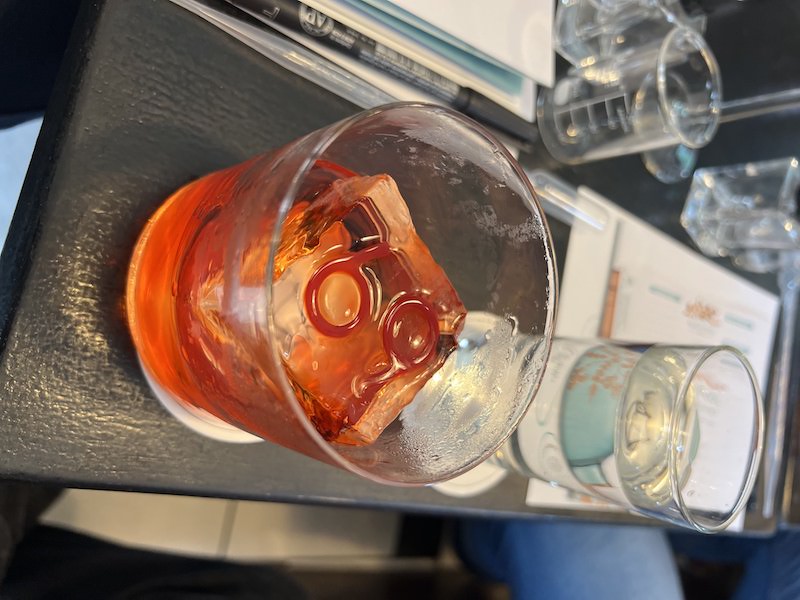
We arrived around 1:50pm in the afternoon. We were the first people there. The front door was open and we were greeted by a woman who told us she would be ready for us in five minutes. A few minutes later, Uros, a bartender whom we knew from past visits came out and welcomed us in. The tables were arranged in a different layout than usual and were facing the front bar where a screen was set up. We sat down at a four-person table by the door. There were only four tables with 4–6 people at each, so there were about 20 of us in total with three staff (Uros, the presenter and a younger bartender). On the tables were many objects and glasses including a tasting glass, water glass, beaker, plastic dropper and a bunch of small dropper bottles with glass pipettes. Today, we were at 69 Colebrooke Row for the Silent Pool Gin Masterclass, which involved tasting four gin cocktails and learning about the Silent Pool Distillery.
We talked with the other two guys from our table (who were from Cyprus and Norway) and after five minutes we were served our first drink in a coupe glass. A Bee’s Knees—one of the classics. A prohibition-style cocktail that used citrus to mask the alcohol. The drink is a twist on a Sour. Sours use sugar and the Bee’s Knees uses honey. We learned later that the Silent Pool Distillery had bees on the same farm that the distillery was located on.
As we sipped our cocktails, the woman introduced herself. Her name was Mari (short for Marion) and she was “Uros’s life partner”. She explained that the main aim of today was to create our own liquid garnish. You can buy their brand of liquid garnishes, which have been created to replace the garnish in your drink.
Mari explained that the distillery is from Albury, Surrey. The film The Holiday was filmed in this village—and the pub from the movie is real and still there. As a French woman, she said that the village of Albury is quintessential British countryside with cottages, dogs running in fields and everyone drives a Land Rover. She explained that the name Silent Pool is not just a name, but a place. It is a spring water pond that is extremely blue (hence why the beautifully designed bottle has a blue tinge to it, in homage to the pool). Silent Pool is a place of myth and legend. She explained that folklore said that a woman woodcutter’s daughter had drowned in the pool after being followed by a man on horseback (King John – the evil King in Robin Hood). She had waded into the cold pond (said to be around 5º celsius) to escape him and drowned soon after. A hat was found by the pool with the crest of King John. The pool is so named because there are rarely any signs of life from the pool, hence the name Silent Pool.
Mari explained that Silent Pool specializes in London Dry gins. These gins do not need to be made in London but rather need to follow a certain process. London Dry Gins are the most difficult to make because of the strict criteria. The most important part is that after the distillation, you can’t add anything except for water.
By this time in the presentation, we were now being served our second cocktail, called the Blush. Uros was asked to explain the drink, which he claimed was similar to a drink called “Twinkle” because when the owner of 69 made the drink for a guest in a Mayfair bar, they loved the drink so much that there was a twinkle in their eye. The Blush was a variation and I guess “blush” is a similar facial expression that is a complimentary reaction.
Uros finished and passed it back to his partner, Mari. She started to explain the distillation process. I had heard this process a few times from the distilleries I had stopped by in Scotland. In this case, the water source and inspiration for the gin was Silent Pool, an ancient spring in the Surrey Hills. After 600 recipe iterations over 18 months, the recipe was finalized, having 24 ingredients in three groups—most found growing in the near vicinity of Silent Pool.
The first group of ingredients included honey, bitter orange peel, cassia bark, coriander seed, green cardamom, Bosnian Juniper, Orris Root Bergamot, Belgian Angelica Root, Liguorice root, Grains of Paradise, Cubeb. Prior to distilling these ingredients are stepped in a high-proof spirit for 24 hours before being transferred directly to the pot. Macerating in alcohol starts to dissolve their oils for improved extractions—this creates deep and rounded flavours which linger on the palate. The Bosnian juniper contributes big, fresh pine with full-bodied, sweet citrus.
The second group of ingredients includes Kaffir lime leaves, rose, linden, lavender, chamomile and elderflower. Due to their more delicate composition, these ingredients are not put directly into the still and instead are put into a “giant tea bag”. After 24 hours, the bag is strained, which transfers the aromatic oils and flavour from these ingredients into the still. This liquid is described as “bright green and oil-rich”.
The third group of ingredients includes fresh lime, fresh orange, Macedonian juniper, Polish Angelica Root, Fresh pear and Dried pear. These ingredients are placed in a basket in the neck of the still, which blocks the path of the vapours. This means that as the distillation occurs, the vapours from the first two groups of ingredients travel up in the still and filter through these ingredients, which strips their essential oils and their flavours. Therefore, in the distilling process, there are (1) ingredients that are placed directly in the still, (2) ingredients that go into a tea bag and just the extracted liquid goes into the still and (3) ingredients that are essentially steamed as the vapours filter through them in the neck of the still. This seemed to be a complex process, but then again, I’m not an expert distiller and it could be standard within the industry.
Mari explained how water boils at 100, but alcohol boils at 82. So alcohol vapour goes up the still, leaving the water behind but transferring the alcohol. The still they use is 1,800 litres (Holstein Still called Ophelia) and yields around 2,000 bottles. When the distillation process has occurred, the spirit is around 87% alcohol and water is added to bring the percentage down to 43%. There is then a one-week resting period, which is said to smooth out the final flavour. The product is then bottled onsite in a bluish bottle (a homage to the blue colour of Silent Pool) and the design of the bottle has illustrations of both the maiden and the evil night.
Mari mentioned how we should go to the distillery to see this being done in person. She explained how the distillery is also very close by and can be reached within two hours. Go to Waterloo station, get on the South Western rail, get off at Guildford and bus 20 minutes to Silent Pool, just outside Albury. (On Google maps, it looks as if there is Albury Vineyard, Deer Trail, and a bike shop called the Spokesman Bicycle Workshop.) Mari explained how the distillery also does a bee-keeping experience in summer that is worth visiting.
Eventually, Mari started speaking about the gins that Silent Pool had. There were three bottles, all London Dry Gins. The first was original. The second was a citrus variation (called Rare Citrus). The third was rose-infused. We began to taste each of them. Mari told us to gently open our mouths when we smelled the gin, which drastically increased the smell/flavour that we inhaled. She said that most people close their mouths to look more proper, but this minimizes the smells and undermines the notion of smelling in the first place. She said that Rose tended to be everyone’s favourite, but I liked the citrus the most. The Original was good and hardly tasted like gin because it was incredibly smooth.
Uros came by after with Negronis, made with silent pool gin. A cool trick they had done was use a clear ice cube that was branded. But then they filled in the impression with a coloured liquid and froze it again.
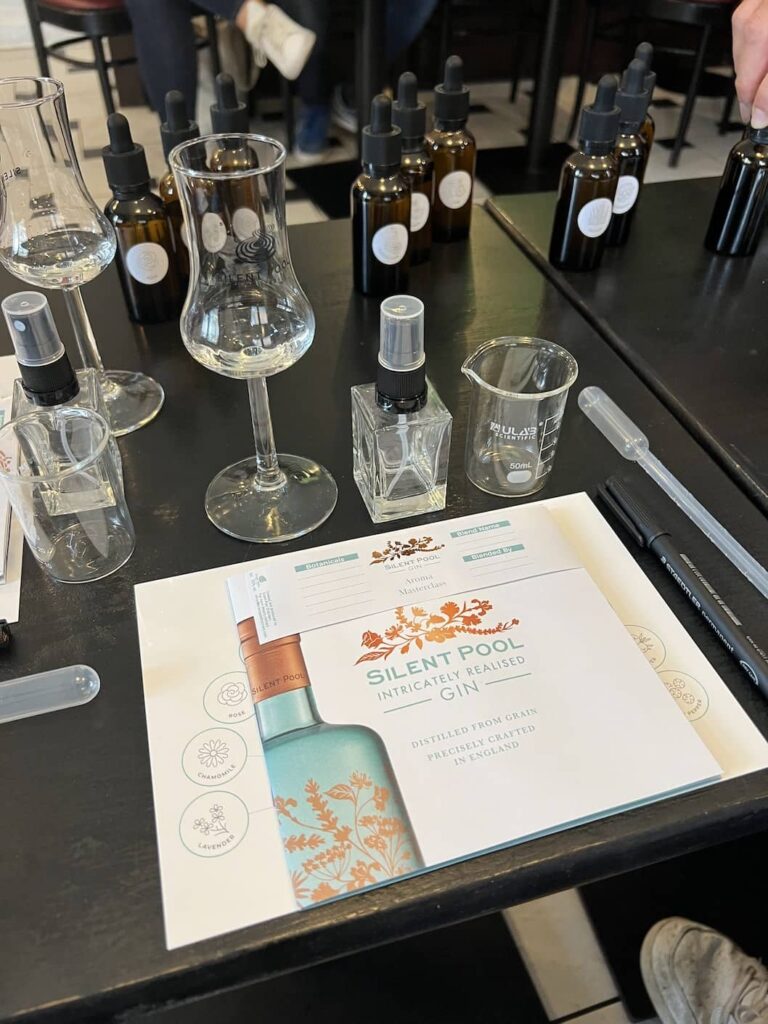

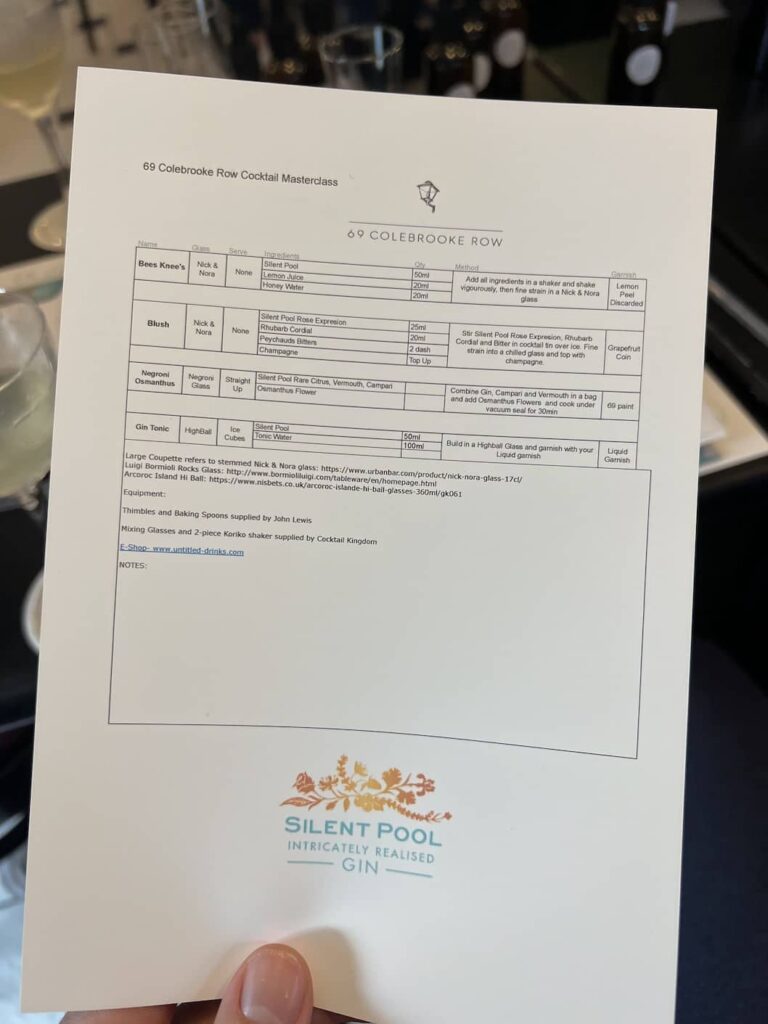
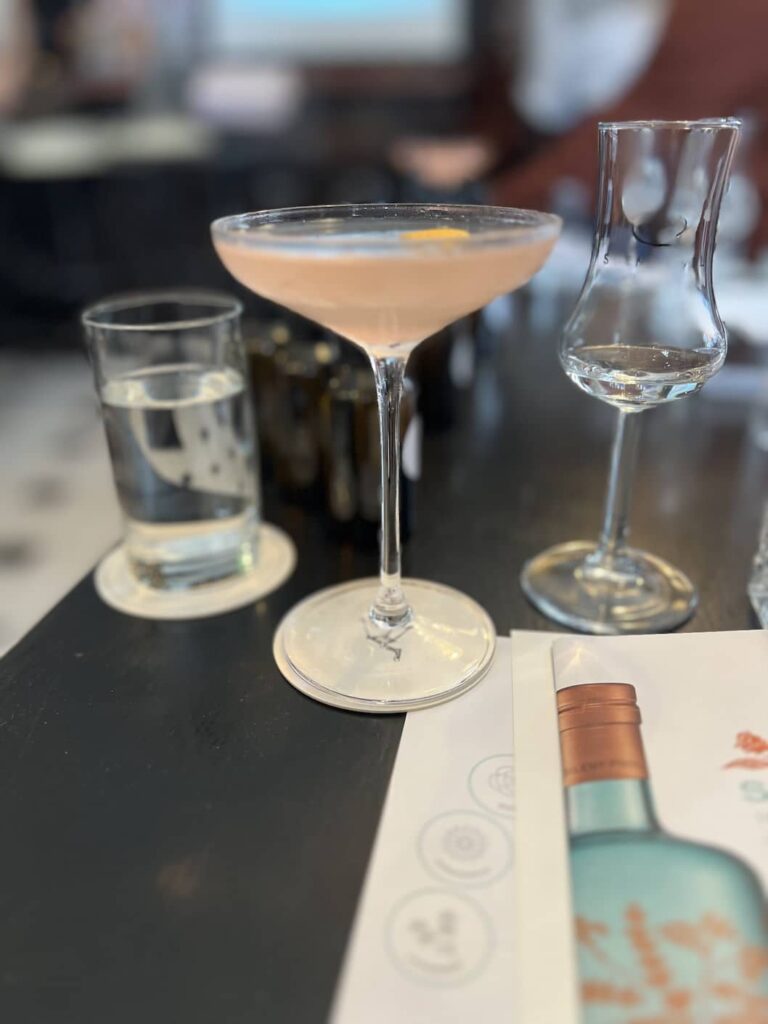
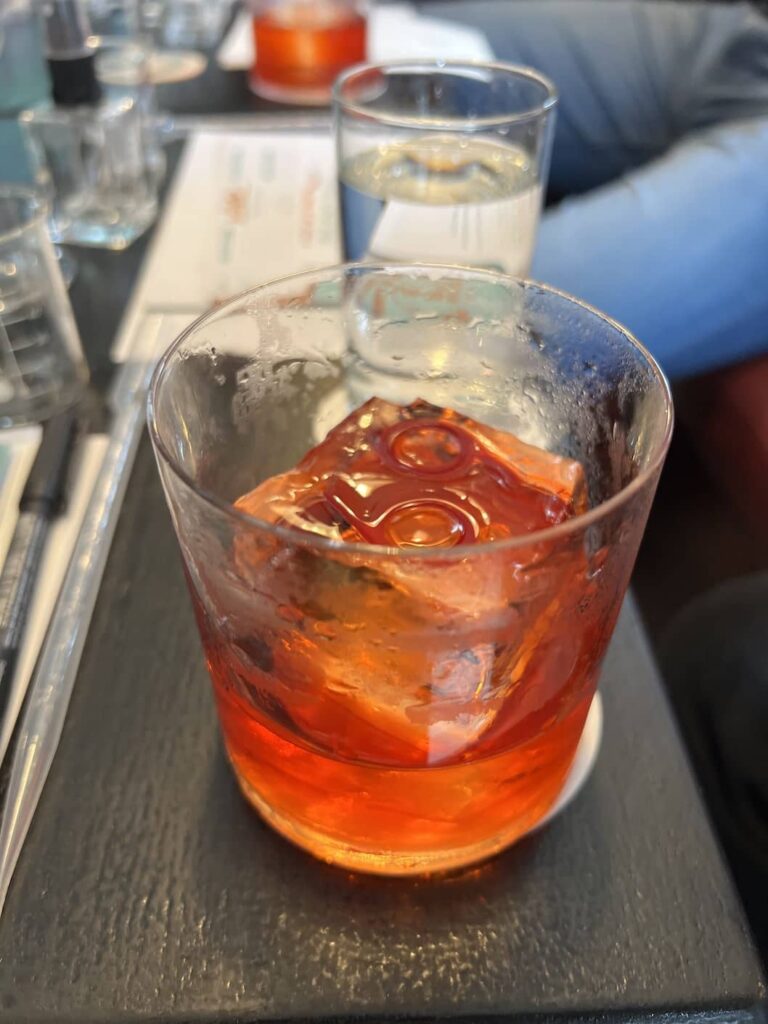
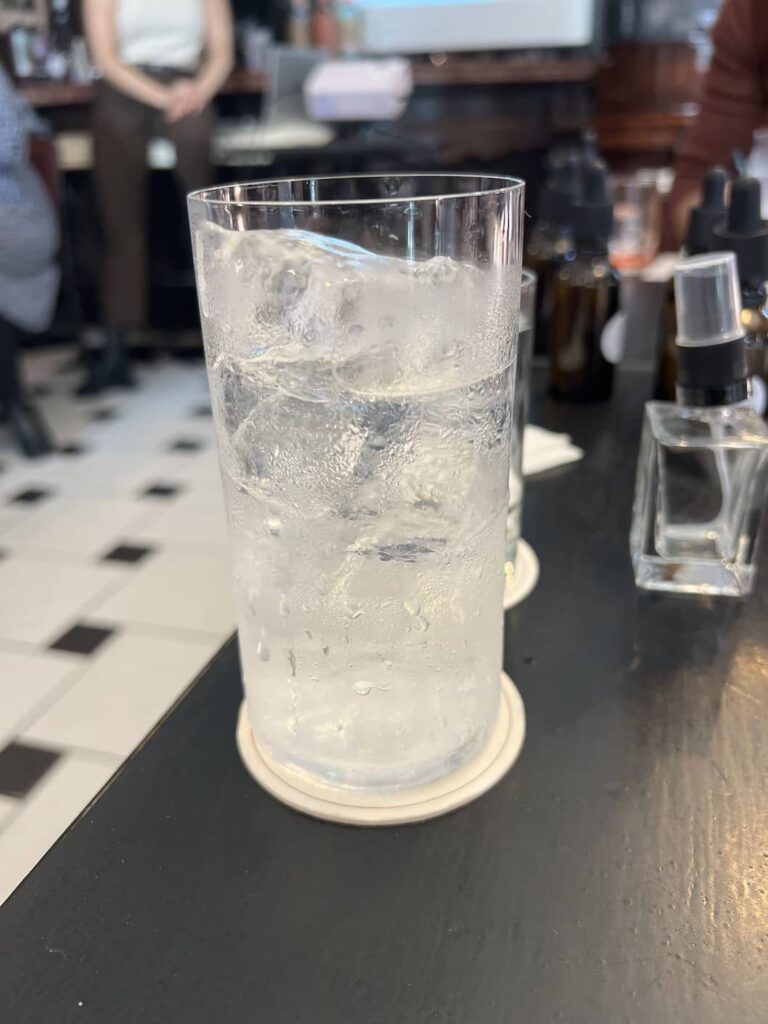

Mari talked about how important smell was. She showed a slide that explained how smell was so closely linked to the brain, which is why it was important. But also why you can smell something and instantly be reminded of a past memory. She asked the room if they had examples. One woman said they had sprinkled the aisle at her wedding with rosemary, so whenever she smelled it, she thought back to it. Another young man said that his mom used rose water in a dish she cooked so when he smelled rose he thought of it. After explaining how important smell was she then segued into making our own garnish spray. By creating this spray, we would essentially replace the solid garnishes that are typical in a drink and be able to easily customize any drink while drastically changing the taste.
Mari introduced the objects that had been on the table the entire time. The dropper bottles had labels on them with single ingredients such as lime, vetiver, orange, to name a few ones. I asked Mari what the liquid was beyond just the flavour on the bottle. She said it was essential oils of the ingredient, alcohol and glycine (so the liquid doesn’t crystallize).

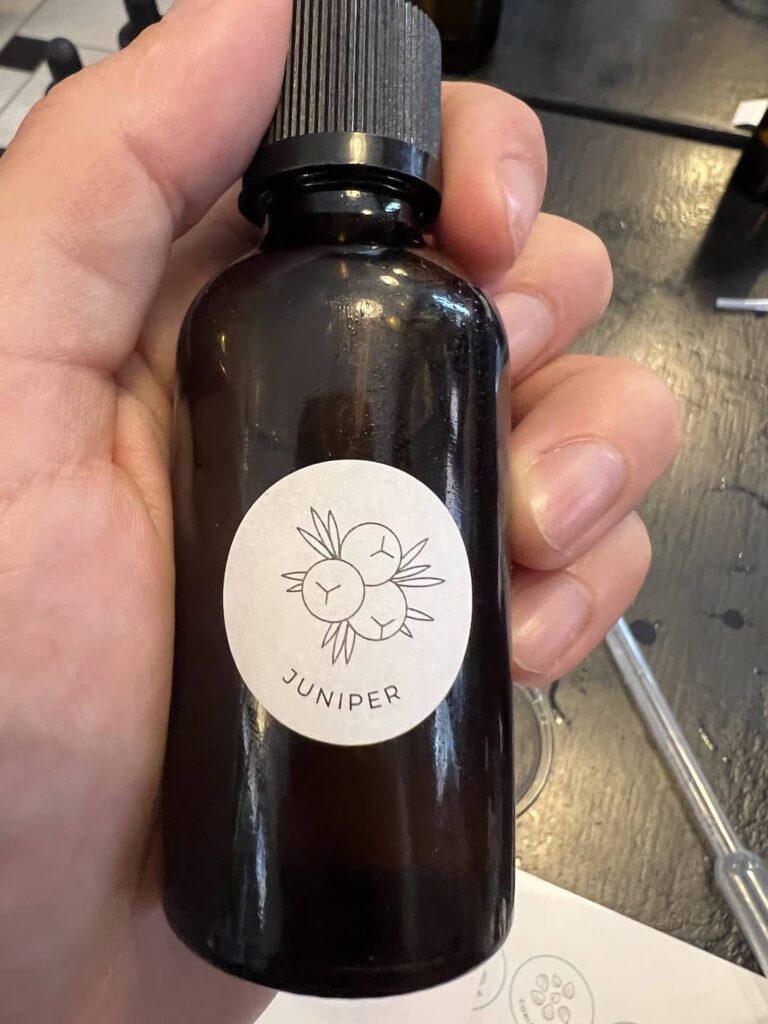
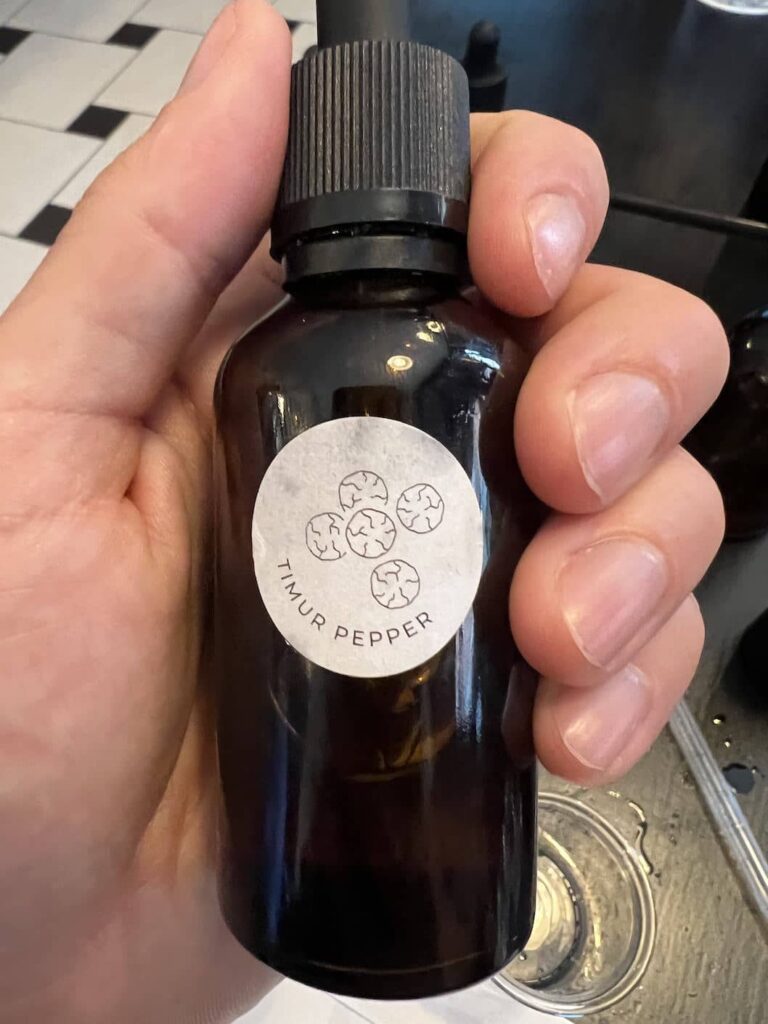
With that, she pointed at the brochure/paper in front of us and asked us to put on 5ml from the four different categories. The options were floral, citrus, herbs and spice. I made mine with rose, orange, Vetiver and Timur Pepper. We then added alcohol to the mixture. To jar this liquid in the spray bottle, we first extracted the flavours using the plastic pipette and transferred it to the beaker. We filled the beaker to the 20ml level (5mls from four categories) and then added 10ml of alcohol, so our final product was 30ml. We then poured the beaker into the spray bottle and added a label. The label said the ingredients in the spray, who it was bottled by and the name of it. I just called mine the 69CR Special Blend. At this point, we had been served gin and tonics, so we sipped them casually and then sprayed our drinks to taste the difference.
Near the end, I Googled who owned Silent Pool because Mari had said it was basically owned by a TV actor/broadcaster. It turned out that William Grant & Sons had purchased them (the owners of Glenfiddich). I asked Mari about it who said that this had just happened a few weeks ago. She said it wouldn’t change the nature of the brand but they would be able to increase production and reach. Currently, they only produce 1M bottles per year and want to increase to 2M.
Before leaving, we chatted with Mari and Uros. I asked Uros how his Milano – Torino bike ride went. He said that they had changed up the route and instead, they bike across England. He explained some details: it generally happens at the start of September and it involves the staff of Bar Termini & 69 Colebrooke Row (owned by the same company). He said that I could email them about joining, in case they have dropouts. But generally, they keep it to the staff, so I would either need to get lucky or be very serious about joining. Good to know. We said our final words and walked out from a very satisfying cocktail class and experience.
Additional Notes:
(1) Four Categories of Aroma:
Floral: Lavender, Chamomile, Rose
Citrus: Lime, Orange, Kaffir Lime
Herbs: Coriander Seed, Vetiver, Cardamom
Spice: Graind of Paradise, Juniper, Timur Pepper
(2) Recommended books to read:
include The Art and Science of Foodpairing by Peter Coucquyt, Bernard Lahousse & Johan Langenbick, Tasty: The Art and Science of What We Eat by John McQuaid and Gastrophysics: The New Science of Eating by Charles Spence, John Sackville, et al.
(3) A note on the experience:
I would serve the G&T after the spray was made. The spray took fifteen minutes to make because we were being walked through the four categories and the step-by-step process of making the liquid garnish. After this time, the ice in my G&T had melted and my drink was a little watery. Still an amazing part of the class, but I think the bartenders would agree that over-dilution is not good for most cocktails.